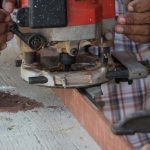Woodworking projects with logs bring a rustic and natural beauty to any home or outdoor space. The versatility of working with logs opens up endless possibilities for creating unique and stunning pieces of furniture, dcor, and outdoor structures. From coffee tables and chairs to charming garden features, log woodworking projects are both aesthetically pleasing and environmentally friendly.
When it comes to woodworking with logs, choosing the right material is essential for the success of your project. Selecting the best logs involves considering factors such as species, size, moisture content, and potential defects. Once you have the perfect logs in hand, the next step is to ensure you have the necessary tools and equipment for proper processing and crafting.
In this article, we will explore the various aspects of woodworking with logs, from selecting the right materials to safety precautions and resources for further learning. Whether you are a seasoned woodworker looking for new inspiration or a beginner eager to explore sustainable and creative woodworking techniques, this guide will provide valuable information on bringing out the best in logs for your next project. So let’s delve into the enchanting world of woodworking projects with logs.
Choosing the Right Logs
When it comes to woodworking projects with logs, choosing the right logs is crucial for the success of your project. Here are some tips on selecting the best logs for your woodworking projects.
Tree Species
Different tree species have different characteristics and properties that make them suitable for specific types of woodworking projects. For example, hardwoods like oak and maple are ideal for furniture making due to their strength and durability, while softwoods like pine and cedar are great for outdoor structures such as benches or arbors. Researching the various tree species and their qualities will help you choose the right logs for your project.
Size and Shape
Consider the size and shape of the logs when choosing them for your woodworking projects. The diameter and length of the logs will determine what kind of items you can create. For example, larger diameter logs may be suitable for creating tables or stools, while smaller diameter logs can be used for decorative pieces or smaller furniture items.
Condition
Inspect the condition of the logs before selecting them for your woodworking projects. Look for signs of rot, insect infestation, or damage that could affect the quality and integrity of your finished piece. It’s important to choose logs that are in good condition and free from any defects that could compromise the structural integrity of your project.
By considering tree species, size and shape, as well as condition when choosing logs for your woodworking projects, you can ensure that you select the best materials for creating beautiful and durable pieces. Whether you’re an experienced woodworker or just starting out with woodworking projects with logs, these tips will help you make informed decisions when selecting your materials.
Tools and Equipment
Woodworking projects with logs require specific tools and equipment to ensure successful and safe execution. Working with raw logs can be a bit different than working with processed lumber, so it’s important to have the right gear on hand. Here are some essential tools and equipment needed for woodworking with logs:
1. Chainsaw: A chainsaw is essential for cutting logs into manageable pieces for your woodworking projects. It’s important to invest in a high-quality chainsaw that is suitable for cutting through hardwood.
2. Drawknife: A drawknife is a versatile tool that is great for debarking and shaping logs. It allows for precision control and is perfect for creating smooth surfaces on the wood.
3. Bandsaw: If you plan on creating intricate designs or cutting thinner pieces from the log, a bandsaw is a useful tool to have in your workshop. It allows for clean and precise cuts, making it ideal for crafting detailed pieces of furniture or home decor items.
4. Lathes: Lathes are used for turning wooden pieces and shaping them into various forms like bowls, vases, or spindles. They are an important tool if you plan on creating turned wood projects from logs.
5. Safety Gear: When working with logs and woodworking tools, it’s crucial to prioritize safety. This means wearing appropriate safety gear such as goggles, gloves, and hearing protection to prevent injury.
In addition to these tools, having a sturdy workbench, clamps, and a moisture meter are also beneficial when working on woodworking projects with logs. With the proper tools at your disposal, you’ll be well-equipped to take on a variety of creative woodworking ventures using raw logs as your primary material.
Preparation
When it comes to woodworking projects with logs, proper preparation of the logs is crucial to ensure successful and long-lasting results. Before you can begin working with logs for your woodworking projects, it’s important to prepare them by debarking and drying them properly.
Debarking the logs involves removing the outer bark from the wood, which not only improves the appearance of the finished project but also helps prevent insect infestation and decay. There are several methods for debarking logs, including using a drawknife, spud, or specialized debarking tool. It’s essential to take your time and work carefully to avoid damaging the wood underneath the bark.
Once you have debarked the logs, the next step is to dry them thoroughly. Properly dried logs are less likely to crack or warp over time, ensuring that your woodworking projects will last for years to come.
Air drying is a common method for drying logs and involves stacking the debarked logs in a location with good air circulation and allowing them to dry naturally over a period of several months to a year, depending on the size and type of wood.
Here are some key considerations when preparing logs for woodworking projects:
- Selecting logs that are free from rot, mold, or insect damage
- Choosing a suitable method for debarking based on the type of wood and your available tools
- Ensuring that the logs are dried slowly and evenly to minimize cracking and warping
By taking the time to properly prepare your logs for woodworking projects, you’ll set yourself up for success and create beautiful, durable pieces that showcase the natural beauty of wood.
| Log Preparation Tips | Debarking Methods |
|---|---|
| Choose healthy, high-quality logs free from rot or insect damage | Drawknife |
| Select a suitable method for debarking based on wood type and available tools | Spud |
| Air dry logs slowly and evenly to minimize cracking | Specialized debarking tool |
Project Ideas
Working with logs in woodworking projects opens up a world of creative possibilities, allowing for the creation of unique and stunning furniture, home dcor, and outdoor structures. The natural beauty and texture of logs add a rustic charm to any project, making them a popular choice for many woodworkers. From simple yet elegant furniture pieces to elaborate outdoor structures, there are countless ways to incorporate logs into your woodworking projects.
One popular project idea for woodworking with logs is creating log furniture such as tables, chairs, benches, and bed frames. The organic shapes and textures of the logs can be used to create visually appealing and functional pieces that add a touch of nature to any interior or exterior space.
For those looking to add a rustic touch to their home dcor, smaller log-based items such as candle holders, picture frames, and coat racks can also be crafted with ease.
In addition to indoor projects, logs can also be utilized in creating outdoor structures such as gazebos, pergolas, and even playhouses. The natural durability of certain types of wood makes them well-suited for withstanding outdoor elements. Whether you’re looking to enhance your backyard or create a unique space in a public area like a park or campground, woodworking projects with logs offer endless opportunities for creativity.
| Log Woodworking Project | Project Idea Description |
|---|---|
| Log Furniture | Create tables, chairs, benches, bed frames |
| Home Dcor | Craft candle holders, picture frames, coat racks |
| Outdoor Structures | Build gazebos, pergolas, playhouses |
Techniques and Tips
Working with logs in woodworking projects requires a different set of techniques and tips compared to traditional woodworking. These methods are essential for creating beautiful and long-lasting pieces from raw logs. Here are some step-by-step instructions and tips for working with logs in woodworking projects:
- Carving: Carving logs can create intricate designs and patterns that add a unique touch to your woodworking projects. Begin by sketching your design onto the log, then use a chainsaw or chisels to carefully carve away the wood. Take your time and work slowly to achieve the desired shape and details.
- Sanding: Sanding is crucial for achieving a smooth and polished finish on your log woodworking projects. Start with coarse sandpaper to remove any rough patches and uneven surfaces, then gradually move to finer grits for a smoother finish. Be sure to sand along the grain of the wood to avoid causing any damage.
- Finishing: Applying a finish is important for protecting your log woodworking projects from moisture, rot, and other potential damage. Consider using a high-quality wood sealant or outdoor finish that is suitable for log furniture or structures. Apply multiple coats as needed, allowing each layer to dry completely before adding the next.
By following these techniques and tips, you can create stunning woodworking projects with logs that showcase the natural beauty of the wood while ensuring durability and longevity. Whether you’re crafting furniture, home dcor, or outdoor structures, mastering these methods will elevate your woodworking skills in working with logs.
Safety Precautions
When working with logs in woodworking projects, it’s important to prioritize safety to prevent injuries and accidents. Logs can be heavy and unwieldy, so it’s crucial to take the necessary precautions to ensure a safe working environment. Whether you’re carving a small project or building furniture from logs, these safety measures are essential for anyone working with wood.
Wear Protective Gear
Before starting any woodworking project with logs, it’s important to wear the appropriate protective gear. This may include safety glasses to protect your eyes from flying wood particles, ear protection to guard against the noise from power tools, and gloves to protect your hands from splinters and cuts. Additionally, wearing a dust mask is essential when sanding or cutting logs to avoid inhaling wood dust.
Work in a Well-Ventilated Area
Working with logs and woodworking tools produces sawdust and fumes that can be hazardous if inhaled. It’s important to work in a well-ventilated area or use a dust extraction system to remove airborne sawdust and maintain clean air quality in the workspace. If working outdoors, be mindful of wind direction and position yourself accordingly to avoid breathing in sawdust.
Use Tools Safely
When using power tools such as chainsaws, drills, or routers for woodworking projects with logs, it’s crucial to follow all safety guidelines provided by the tool manufacturer. Always keep your hands away from cutting edges, secure workpieces properly before cutting or drilling, and never remove safety guards from power tools. Additionally, keep work areas clear of clutter and tripping hazards to prevent accidents while handling tools.
By following these safety precautions when working with logs in woodworking projects, you can minimize the risk of accidents and create a safe environment for your creative endeavors. Whether you’re a beginner or experienced woodworker, prioritizing safety is essential for enjoying the craft while protecting yourself from potential harm.
Resources and References
In conclusion, working with logs in woodworking projects opens up a world of creative possibilities. Whether you are looking to create rustic furniture, unique home decor pieces, or sturdy outdoor structures, the natural beauty and versatility of logs can bring a unique, organic charm to your projects. By carefully selecting the right logs and using the proper tools and techniques, you can transform raw logs into stunning creations that will be both functional and visually appealing.
When it comes to obtaining logs for your woodworking projects, there are several sources to consider. Local sawmills, tree removal services, and even your own property can be great places to find the perfect logs for your projects. Additionally, there are plenty of recommended books, websites, and videos available that offer insight and inspiration for working with logs in woodworking. These resources provide valuable information on everything from log selection and preparation to project ideas and finishing techniques.
As with any woodworking project, it is important to prioritize safety when working with logs. From using sharp tools and heavy machinery to handling heavy materials, there are inherent risks involved in woodworking with logs.
Be sure to follow safety precautions such as wearing protective gear, working in a well-ventilated area, and seeking guidance from experienced woodworkers when necessary. With the right approach and respect for safety measures, you can enjoy the rewarding experience of creating beautiful woodworking projects with logs while staying safe throughout the process.
Frequently Asked Questions
What Can I Make From Wooden Logs?
Wooden logs can be used for a variety of woodworking projects such as furniture, art pieces, home decor, and even outdoor structures like fences or decks. From log cabins to coffee tables, the possibilities are endless.
What Woodworking Project Is Most Profitable?
The most profitable woodworking project can vary depending on one’s skill level and market demand. However, high-quality furniture pieces such as dining tables, bed frames, and custom cabinets are often sought after and can yield a good profit when sold.
What Can I Do With Spare Logs?
Spare logs can be repurposed into smaller DIY projects such as coasters, candle holders, or stools. They can also be used for firewood, building rustic shelves, or even transformed into unique planters for the garden. Additionally, some may choose to sell spare logs to woodworkers or artisans who could use them for their own projects.

Hi everyone! I’m a woodworker and blogger, and this is my woodworking blog. In my blog, I share tips and tricks for woodworkers of all skill levels, as well as project ideas that you can try yourself.





